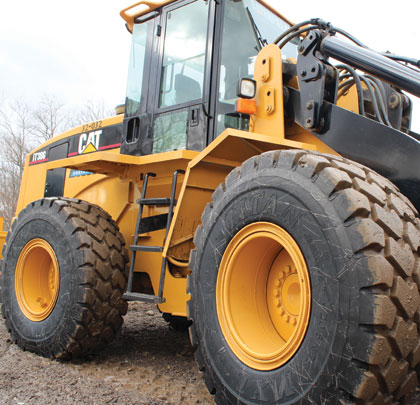One of the most important factors in tire selection is tread choice, and that all starts with understanding the tire codes.
THE ABCS AND 1-2-3S OF TREAD
The Tire and Rim Association (TRA) has made letter and number designations for treads that apply to all tire manufacturers.
- E (earthmover): Designed for haulage and transport of materials on unimproved surfaces at up to 40 mph and up to 2.5 miles at a time.
- G (grader): Designed for grading material over unimproved surfaces at speeds up to 25 mph and for unlimited distances.
- L (loader): Designed for use on loaders and dozers that do not exceed 5 mph and distances of 250 feet each way.
Each of these letters is followed by a number that denotes tread depth and style. For instance, E-3 would indicate an earthmover tire with a rock tread pattern at standard tread depth.
- 1: Denotes rib tread with standard depth for use in earthmoving (E) applications primarily on roads.
- 2: Denotes traction tread with one-to-one lug-to-void ratio and a standard tread depth for use in E, G, and L applications that require traction on soft surfaces.
- 3: Denotes rock tread with two-to-one lug-to-void ratio and a standard tread depth for use in E, G, and L applications in average hard-surface conditions.
- 4: Denotes rock tread with a two-to-one lug-to-void ratio and tread that is 1.5 times deeper than standard for use in E, G, and L applications in harsh, rocky conditions.
- 4S: Denotes smooth tread pattern with no lugs and a tread that is 1.5 times deeper than standard for use in L applications on hard surfaces where traction isn’t a concern.
- 5: Denotes rock tread with a two-to-one lug-to-void ratio and tread that is 2.5 times deeper than standard for use in L applications in the most severe working conditions.
- 5S: Denotes smooth tread pattern with no lugs and a tread that is 2.5 times deeper than standard for use in L applications in severe working conditions that require wear-resistance over traction.
- 7: Denotes rib pattern with a shallow tread that is 60 percent as deep as standard for use in E settings where flotation and minimal ground disturbance is required.
TREAD COMPOUND
Unlike the numbers and letters denoting tread style, there is no industry standard for how compounds are denoted, since each tire manufacturer develops proprietary compounds.
However, the choices for radial tires often fall in to one of several categories.
- Cut-resistant (C): Formulated for protection from chipping and tearing in rocky applications.
- Wear-resistant (W): Formulated for extending the wear of the tread in load and carry applications with frequent stopping and starting.
- Heat-resistant (H): Formulated for haulage applications with heavy loads, long distances, and high speeds.
ACRONYMS, NOMENCLATURES, AND DESIGNATIONS
In case tire manufacturers haven’t thrown enough letters and numbers at you just to describe the tread design, there are a number of other standard codes that are important to understand when making a purchase decision.
- Star rating and load/speed index: These metrics denote the recommended air pressure and load carrying capacity for radial tires at various speeds. An example marking would be an E-3 ** 185 B. The stars indicate recommended air pressure, while the 185 indicates the load and B denotes the maximum speed for the tire. The ratings are too many to memorize, so it’s best to consult the manufacturer’s load/inflation tables to ensure the tire you’re selecting is appropriate for the vehicle weight and speed.
- Ply rating: This metric measures the strength and load carrying capacity of bias tires. The higher the ply number, the higher the maximum allowable air pressure and load carrying capacity.
- Sizing nomenclatures: The standard format for identifying tire size calls out the following metrics: section width aspect ratio, type of tire (radial/bias) and rim diameter. For instance, a designation of 18.00-25 would indicate the tire is 18 inches wide, with an aspect ratio of 1.0 (shown by the 00), bias construction (shown by the dash) and 25-inch rim diameter. An aspect ratio of 0.8 is always denoted by adding 0.5 to the section width, and an R (rather than a dash) indicates radial. For instance, a 23.5R25 is a radial with a 0.8 aspect ratio. Any other aspect ratio is typically called out after the section width. For instance, a 45/65R45 has an aspect ratio of 0.65 or 65 percent. While these numbers are important to understand, generally the equipment manufacturer dictates the tire size, rather than the equipment owner.The one exception to this rule would be if an owner wants to switch to Low Sidewall (LSW) tires.
- LSW: LSW is a term used to describe tires with a shorter sidewall and larger rim than standard tires. LSW assemblies offer additional stability for a machine, which improves ride quality, breakout force, and handling. They can be identified by the LSW acronym or by the larger rim diameter in the size nomenclature. For instance, the LSW equivalent of a standard 20.5R25 loader tire would be identified as 20.5R34.5 LSW.
COMBINATION FOR THE APPLICATION
Many of the construction tires on the market are available in numerous combinations of compounds, tread styles, and ply or star ratings. Finding the right combination of each comes down to how and where you intend to use your machine. Making an informed decision will ultimately lead to increased productivity and longevity of your tires, but you can only do so if you understand the tire codes. ■
About the Author Johni Francis is global product manager at Titan Tire Corporation. He has held numerous roles at the company, including field engineering, and he spends much of his time visiting end-users in the field to help them develop effective tire management plans.
Modern Contractor Solutions, August 2014
Did you enjoy this article?
Subscribe to the FREE Digital Edition of Modern Contractor Solutions Magazine!



